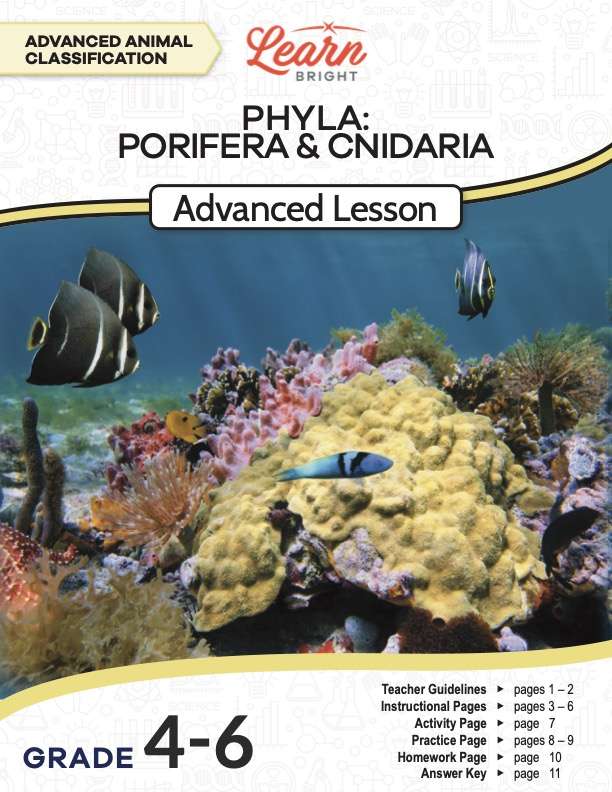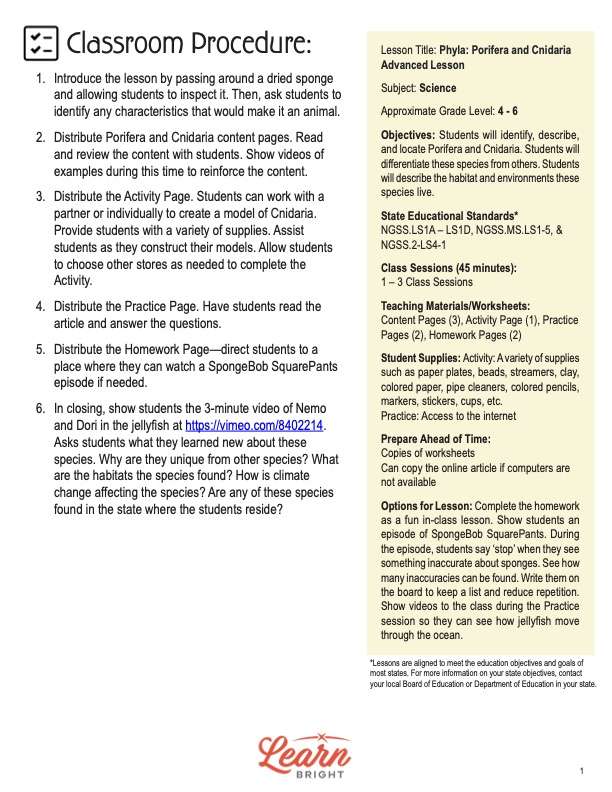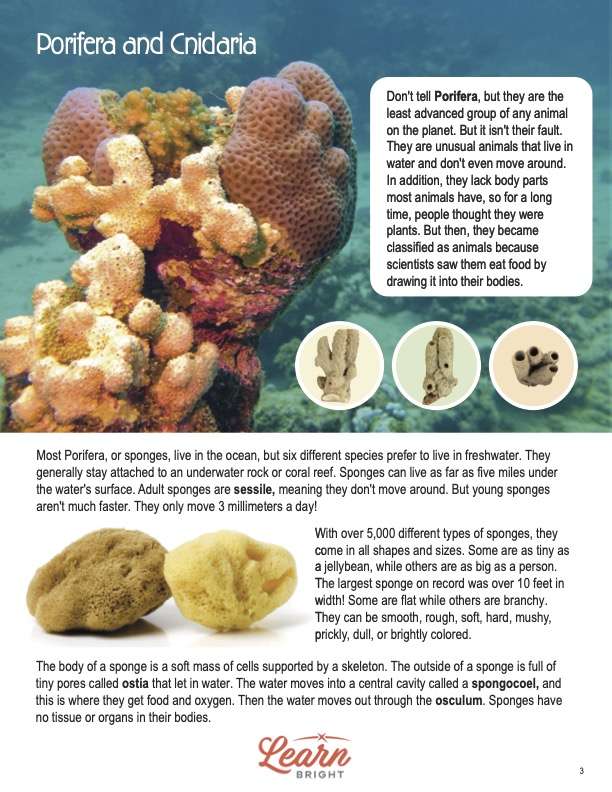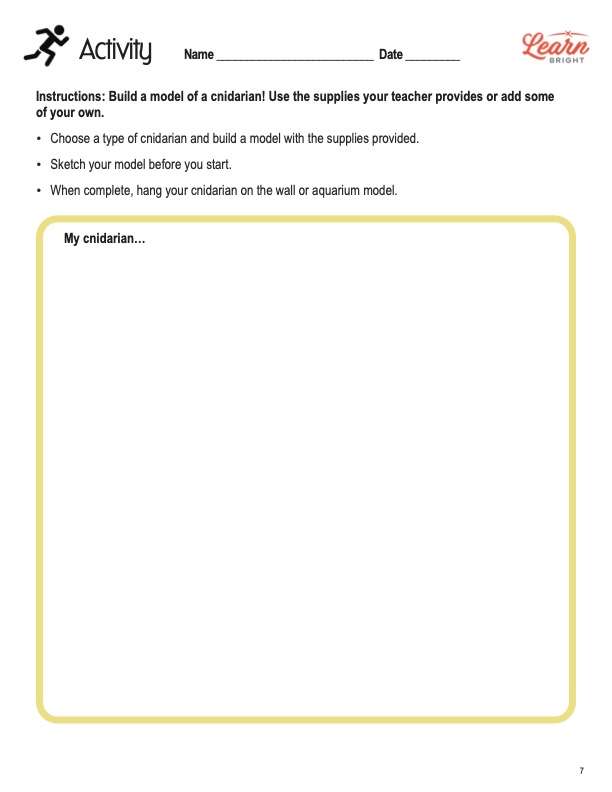Description
What our Phyla Porifera and Cnidaria Advanced lesson plan includes
Lesson Objectives and Overview: Phyla Porifera and Cnidaria Advanced teaches students some interesting information about these aquatic creatures. Students will discover how to identify and locate species in each phylum and describe their habitats and environments. This lesson is for students in 4th grade, 5th grade, and 6th grade.
Classroom Procedure
Every lesson plan provides you with a classroom procedure page that outlines a step-by-step guide to follow. You do not have to follow the guide exactly. The guide helps you organize the lesson and details when to hand out worksheets. It also lists information in the yellow box that you might find useful. You will find the lesson objectives, state standards, and number of class sessions the lesson should take to complete in this area. In addition, it describes the supplies you will need as well as what and how you need to prepare beforehand. This lesson requires several materials, including paper plates, beads, clay, pipe cleaners, markers, stickers, and cups.
Options for Lesson
There are suggestions in the “Options for Lesson” section of the classroom procedure page for additional activities or ideas. Complete the Homework as a fun, in-class lesson. Show students an episode of SpongeBob SquarePants. During the episode, students say “Stop” when they see something inaccurate about sponges. See how many inaccuracies they can find. Write them on the board to keep a list and reduce repetition. Show videos to the class during the Practice session so they can see how jellyfish move through the ocean.
Teacher Notes
The teacher notes page provides an extra paragraph of information to help guide the lesson and remind you what to focus on. The blank lines on this page are available for you to write out thoughts and ideas you have as you prepare the lesson.
PHYLA PORIFERA AND CNIDARIA ADVANCED LESSON PLAN CONTENT PAGES
Porifera
The Phyla Porifera and Cnidaria Advanced lesson plan contains four content pages. It starts by explaining an interesting fact about porifera. They are the least advanced group of any animal on the planet. But it isn’t their fault. They are unusual animals that live in water and don’t even move around. In addition, they lack body parts most animals have, so for a long time, people thought they were plants. But then scientists classified them as animals because they saw them eat food by drawing it into their bodies.
Most porifera, or sponges, live in the ocean, but six different species prefer to live in freshwater. They generally stay attached to an underwater rock or coral reef. Sponges can live as far as five miles under the water’s surface. Adult sponges are sessile, meaning they don’t move around. But young sponges aren’t much faster. They only move 3 millimeters a day!
With over 5,000 different types of sponges, they come in all shapes and sizes. Some are as tiny as a jellybean while others are as big as a person. The largest sponge on record was over 10 feet in width! Some sponges are flat while others are branchy. They can be smooth, rough, soft, hard, mushy, prickly, dull, or brightly colored.
The body of a sponge consists of a soft mass of cells supported by a skeleton. The outside of a sponge is full of tiny pores called ostia that let in water. That water moves into a central cavity called a spongocoel, and this is where the sponges get food and oxygen. Then the water moves out through the osculum. Sponges have no tissue or organs in their bodies.
Interesting Facts about Sponges
Some Porifera are carnivorous, meaning they only eat meat. And their favorite food is crab. That’s probably because crabs are the easiest for them to catch. When a crab scuttles over a sponge, the sponge can detect the crab with its spicules. Spicules are Velcro-like structures that cause the crab’s legs to stick to the sponge. Every cell in a sponge is independent. So even when it “eats” the crab, each cell works independently to digest the food.
Sponges can live for up to 200 years. But did you know that when a piece of a sponge is broken off, it will grow to become a new sponge? This is fragmentation and is a form of asexual reproduction.
People use sponges for all kinds of things! The ancient Greeks and Romans utilized sponges to pad their war helmets and armor. People use sponges for bathing, cleaning, painting, and even collecting. But don’t worry—you are the only animal in your shower. The types of sponges you have in your house today do not come from animals. They are made in a factory.
Cnidaria
Cnidaria (nih-DARE-ee-uh) is a phylum that contains animals only in aquatic environments. It has over 10,000 species that all live in both freshwater and saltwater. All cnidarians have one unique, distinguishing feature—cnidocytes. Cnidocytes are specialized cells that help them with capturing prey.
There are five classes of cnidarians, and jellyfish are in four! Anthozoa include sea anemones and corals. Scyphozoa are “true” jellyfish, and cubozoa are box jellies. Hydrozoa are hydroids (Portuguese man o’ war and hydra), and staurozoa are stalked jellyfish.
These water animals most often have a simple, symmetrical body with a mouth opening. Cnidarians are water animals with a simple, usually symmetrical body shaped like a bell (jellyfish) or look like tubes anchored to a single spot (coral or sea anemones). There are two types of cnidarians: swimming medusae or sessile polyps. Regardless of the type, they both have tentacles around the mouth. The tentacles have stinging cells (cnidocytes) to help them catch prey. These specialized stinging cells are where cnidarians get their name!
Their prey include plankton floating in the water to animals that are several times larger than they are. Cnidarians are both predators and prey because starfish, sea slugs, fish, and turtles find them delicious snacks. Their bodies are made of mesoglea, which is a non-living jelly substance. The mesoglea is in between two layers of the epithelium (covering made out of tissues) like a sandwich. They have a single body cavity for respiration and digestion.
Interesting Facts about Cnidarians
While they do not have any respiratory organs, they absorb oxygen from the water and expel carbon dioxide. Medusae swim by using a form of jet propulsion. They squeeze water out of their body cavity, and the mesoglea’s lightness helps them propel forward (or up). The hydras move very slowly over rocks and beds by creeping like snails, crawling like worms, waggling their bases, or doing somersaults!
Do cnidarians have brains? Not really. While they don’t have a central nervous system, they have a collection of neural tissue that could be a processing center. The really cool thing all cnidarians can do is regenerate. If they lose a part, it grows back! This helps them to recover from any injuries.
Are jellyfish dangerous? While jellyfish stings can be quite painful, most of the time, they only cause humans mild symptoms. However, some jellyfish can be quite hazardous to humans. The “sea wasp” jelly is believed to be the most venomous of all and is responsible for almost 70% of all deadly stings yearly. Sea wasps are practically transparent, so it is tough to identify them!
Not all cnidarians are harmful to humans. For example, coral reefs are economically important because they provide fishing grounds, protect shores from currents and tides, and are hubs for tourism. Some of the larger jellyfish have become a delicacy in Japan, Korea, and other parts of Asia. The value of the jellyfish depends upon the skill level of the person preparing them. These preparers are called Jellyfish Masters and guard their cooking secrets very carefully!
PHYLA PORIFERA AND CNIDARIA ADVANCED LESSON PLAN WORKSHEETS
The Phyla Porifera and Cnidaria Advanced lesson plan includes three worksheets: an activity worksheet, a practice worksheet, and a homework assignment. These worksheets will help students demonstrate what they learned throughout the lesson and reinforce the lesson concepts. The guide on the classroom procedure page outlines when to hand out each worksheet to your students.
CNIDARIAN MODELS ACTIVITY WORKSHEET
Students will build a model of a cnidarian for the activity. They will use the supplies you provide and can add some of their own. First, they must choose a type of cnidarian to model. They can sketch a picture in the box on the worksheet page before they build the model itself. When they finish, students can hang their cnidarian models on the wall or in a model aquarium.
GATHER THE FACTS PRACTICE WORKSHEET
The practice worksheet requires students to review an online article about how jellyfish swim and eat. There is a list of questions for students to answer based on the information in the article. If the article does not work, for whatever reason, feel free to research another one and adjust questions accordingly.
PHYLA PORIFERA AND CNIDARIA ADVANCED HOMEWORK ASSIGNMENT
For the homework assignment, students will watch an episode of “SpongeBob SquarePants” (you could watch as a class). They will then explain three scientific inaccuracies about sponges in the spaces provided.
Worksheet Answer Keys
There are answer keys for the practice and homework worksheets in the lesson plan document. All the correct answers are in red to make it easier to compare them with students’ responses. There may be variation on students’ answers on the homework given the nature of the assignment. If you choose to administer the lesson pages to your students via PDF, you will need to save a new file that omits these pages. Otherwise, you can simply print out the applicable pages and keep these as reference for yourself when grading assignments.










